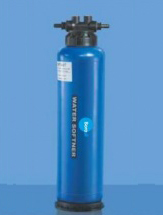
Water Softener
 Water softeners contain high capacity strong acidic caution exchanger in bead form. It is used in sodium form to remove hardness due to Ca & Mg ions. During Service Period:-
Water softeners contain high capacity strong acidic caution exchanger in bead form. It is used in sodium form to remove hardness due to Ca & Mg ions. During Service Period:-RSO3Na + CaCl2 = (R.SO3)2Ca + 2 NaCl
RSO3Na + MgCl2 = (R.SO3)2Mg + 2 NaCl
Thus calcium & magnesium hardness is removed & replaced with more soluble sodium ions in form of sodium chloride. When this soft water is fed into distillation unit, scale formation is reduced drastically & sodium chloride starts to settle at the bottom of boiler over a period of time. This can be easily removed by using concentrated hydrochloric acid.
The softener has been recharged once in two months depending upon the hardness of water at customers place. To recharge 10-15% sodium chloride solution is used & passed through the softener. This unit is not recommended for where there is very high TDS of more than 600 PPM.
Regeneration
(R.SO3)2Ca + 2 NaCl = R.SO3Na + CaCl2
Note:- When raw water is fed to distillation unit. Calcium & magnesium carbonates & chlorides (Hardness) settle in the boiler. This hardness does not get dissolved even when heated with HCL or HNO3. Hence, a water softener is used.
Water softener can be used only where total hardness of water is less than 400 PPM. TDS of water does not reduce/change by using water softener.
The hardness test is performed as follows:-
- Take 25 ml of water
- Add 5 drops of ammonia buffer solution.
- Shake it & then add a pinch (2 crystals) of Erichrome black T- Indicator.
- The Colour turns red. (In Case the colour turns blue at this stage only it means zero PPM hardness).
- Now add drop by drop N/50 EDTA Solution until the colour turns blue. Each drop is 2ppm of hardness.
| Description | Concentration |
|---|---|
| Very hard | over 300 PPM |
| Hard | 150 – 300 PPM |
| Moderately Hard | 50 – 150 PPM |
| Soft | 0 – 50 PPM |
- Use the softener, perform the test & see the result. The hardness should be between 0-50ppm.
- In case the softener has not been used for some time or has been kept idle, charge the Softener using Sodium Chloride solution & then perform the test.
- The white colour deposits which forms is due to precipitation of sodium chloride upon heating & not due to calcium.
- Perform the hardness test if your water is showing more than 300ppm even after using softener, then it means you need to recharge it. Follow the steps mentioned below:-.
- Disconnect the inlet & outlet rubber tubing.
- Prepare Sodium chloride solution by adding approximate 200 grams Sodium chloride to 20 liters distilled or de-ionized water.
- Pass the sodium chloride solution through the softener inlet drop by drop. The outlet can be left to the sink. The solution should pass through the softener for period of 45 minutes. Rinse it with de-ionized water & it is ready for use once again.
| N/50 EDTA solution | …Rs. 195/- per 500 ml. |
| Erichrome Black ‘T’ | …Rs. 270/- per 25 grams |
| Ammonia Buffer Solution Make:- Emerck/Ranbaxy/Glaxo/Nice. Available at all Scientific Dealers. | …Rs. 205/- per 500 ml |
- In case you are using water softener for distillation units, connect the inlet to the sink and outlet to the distiller. The flow of water can be controlled by a pinch cock so that the rate at which the water flows through the softener should be slightly at a higher rate to that of distilled water flow. The colour of the water (yellow) is due to the colour of the resin present in water softener. It does not influence the quality of the distilled water.
- Kindly drain the water in the boiler every day after switching off the unit. This can be done by opening the pinch cock provided at the bottom of the boiler. Discard this water. By doing this most of the sediments present in the boiler is removed. Feed the boiler with fresh water next day.
Our Products

